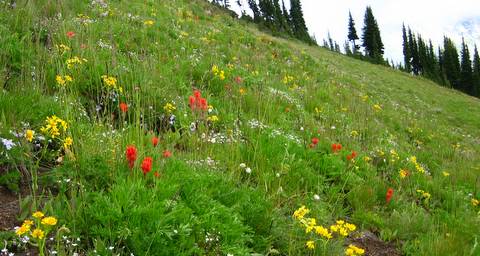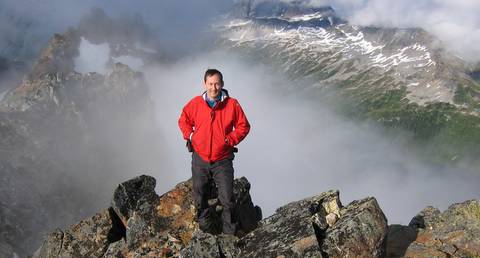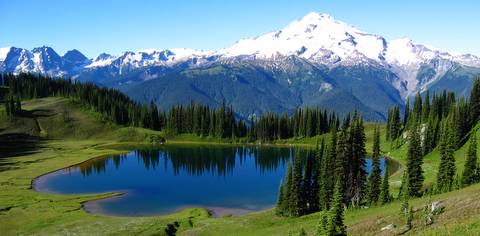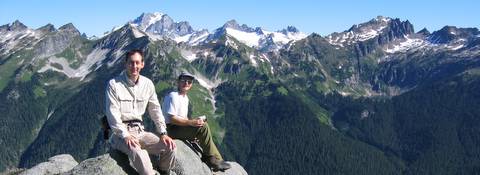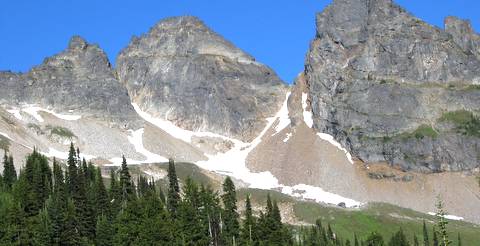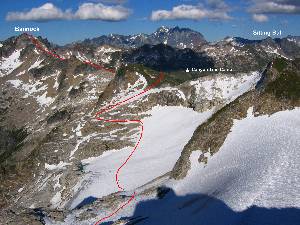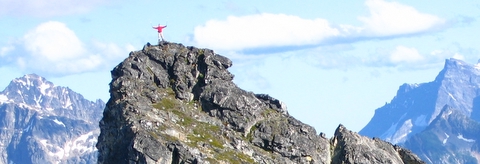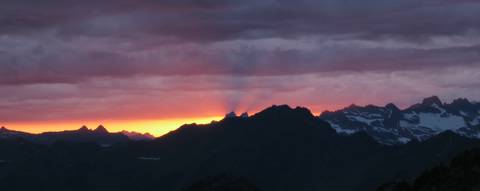|
|
|||||||||||||||||||||||||||||||||||||||||||||||||||||||||||||||||||||||
Bath Lakes High Route(USGS Downey Mtn, Lime Mtn, Gamma Peak, Suiattle Pass, Agnes Mtn;GT Glacier Peak, Holden, McGregor, Cascade Pass)July 15-20, 2005
|
|||||||||||||||||||||||||||||||||||||||||||||||||||||||||||||||||||||||
|
Party:† Matt Burton, Mike Torok Introduction:† The Bath Lakes High Route follows a ridge of 7000-foot peaks in the heart of the Cascades, but the ridge is unnamed, little-traveled, and little-known, so here are some ways to describe it:
|
|||||||||||||||||||||||||||||||||||||||||||||||||||||||||||||||||||||||
|
|
|||||||||||||||||||||||||||||||||||||||||||||||||||||||||||||||||||||||
Day OneSuiattle River Trail (1800) to Minerís Ridge Trail (2800) to Minerís Junction Camp (4800)
We started with the low end of the route due to fear of rain. The fear was well-founded. The day went from humid to drizzling to raining to just plain wet.
We had originally planned to begin with the high part of the route, but decided to reverse our loop and begin low due to rain and clouds. It rained the first day, and the clouds didnít clear till the end of the second day, so we were glad not to be trying to navigate the high country.
To reach the trailhead (1800 feet), we had to hike the last 2ľ miles of the Suiattle River Road, because itís closed where the Downey Creek bridge washed out in the October 2003 floods. To cross Downey Creek, we climbed the makeshift ladder from the shore up onto the concrete bridge, which is standing in the middle of the creek with no approach ramp on its west end. Then we hiked Suiattle River Trail #784 along the river for 10.8 miles to Minerís RidgeTrail #785 (2800 feet). During the first few miles along the river, we had to go around four washouts. Below we could see the river running gray with the huge amount of silt that washes down from Glacier Peak.
Matt wet and tired at camp, but at least I have tea. 9:30 hours, 15.5 miles, 3380 gain.
|
|||||||||||||||||||||||||||||||||||||||||||||||||||||||||||||||||||||||
Day TwoMinerís Junction Camp (4800) to Lady Camp (6200) to Plummer (7870).
|
|||||||||||||||||||||||||||||||||||||||||||||||||||||||||||||||||||||||
|
All morning long, the rain continued to drum on the tent,
so we just stayed in bed till 11:30. Well, at least the 14-hour nap helped me
catch up on my sleep deficit. It was still misty and damp as we headed up the
trail to the junction with the Suiattle Pass trail, and then up to Lady Camp
at 6200 feet.
Here the terrain makes a breath-taking change of foliage from
enclosed forest to open meadows. We had walked through a few flowery meadows
earlier, but here the slope of Minerís Ridge stood up above us like a terraced
green wall practically glowing in the damp overcast. While we pumped
water, a marmot even came out to greet us. We set up camp and headed up the eastern ridge toward
Plummer. The lower slopes of Plummer were wonderful fields of flower, with
their colors accented in the soft misty light.
Higher up the peak was rocky
but easy scrambling, with the crest hidden in the clouds.
As we descended, the sun angled low across the crest and cast a rainbow halo
of my own shadow onto the clouds below.
After dinner at camp, we sat in the
meadow with our hot beverages and watched the sunset light up Glacier Peak as the clouds filled the
valley below. |
|
||||||||||||||||||||||||||||||||||||||||||||||||||||||||||||||||||||||
|
|
|||||||||||||||||||||||||||||||||||||||||||||||||||||||||||||||||||||||
Day Three
|
|||||||||||||||||||||||||||||||||||||||||||||||||||||||||||||||||||||||
|
|
|||||||||||||||||||||||||||||||||||||||||||||||||||||||||||||||||||||||
|
Image Lake lived up to its reputation as a scenic gem, beautiful from every angle. As we approached from the west, the lake glowed deep green reflecting the opposite hillside. From the north shore, the lake reflected a perfect line of trees framing Glacierís white cone. When I went in for a swim, the water was a perfect refreshing warm-cool temperature, and the scenery reflected in waves rippling out around me. Meanwhile Mike circumnavigated the lake and backtracked to the Canyon Lake junction, so that he could hike the whole trail. I hiked up the slopes north of the lake to meet Mike at the col (6400) where the trail crosses Minerís ridge. From high on the northern hillside, the lake was a blue gem surrounded by green meadows and backed by big peaks.
A brief side trip took us to the summit of Minerís Ridge (6768) for a grandstand view of the Bath Lakes Traverse Peaks and a sweeping panorama of the surrounding area: south to Image Lake, the Suiattle valley & Glacier Peak; east to Plummer and Bonanza; north to the Canyon Creek valley, Canyon Lake, the Bath Lakes Peak, and Dome Peak. On the way down, a marmot came out its hole and posed for me with Image Lake below.
We took the Canyon Lake trail in a broad sweep down and around the head of the Canyon Creek drainage. The unmaintained trail was in good condition, with the tread missing in just a few gullies on the side of the ridge. We continued to the second fork of Canyon Creek (5350) where we dropped our backs for a side trip to Sitting Bull Mtn.
Sitting Bull gave us our first experience of off-trail travel on steep meadows. Going up a thousand feet on the meadows, we learned to carefully watch the colors of the greenery ahead, since some plants gave better footing than others. A snow finger took us to the notch south of the summit, where we faced a couple hundred feet steep third class (or more) scrambling and then easier terrain to the summit (7759).
We went down to the trail, then followed the trail as it climbed back up to about 6300 feet traversing the head of the valley before dropping to Canyon Lake, which was already dropping in to shadow. Up high in the evening sunshine, we decided to make camp where the trail was traversing a delightful region of small streams splashing down curving rock slabs. I found a small waterfall that for an evening shower before dinner, and we watched the moon rise as the sun faded.
12:30 hours, 9 miles, 4500 gain. |
|
||||||||||||||||||||||||||||||||||||||||||||||||||||||||||||||||||||||
|
|||||||||||||||||||||||||||||||||||||||||||||||||||||||||||||||||||||||
Day Four
|
|||||||||||||||||||||||||||||||||||||||||||||||||||||||||||||||||||||||
|
We dropped down to buggy
Canyon Lake then climbed back up to Totem Pass. A side trip to Bannock
provided a view of the whole length of the high route stretching west. We
traversed the snowy north side of the ridge from Totem Pass to Stonehenge Col.
Then we took turns climbing the summits flanking the col and set another fine
high camp on flat contours south of the col. |
|||||||||||||||||||||||||||||||||||||||||||||||||||||||||||||||||||||||
|
We left camp about 8am traversed another half mile before the trail dropped steeply down to Canyon Lake (5605). The lake itself was clear water nestled against the cliffs rising to Bannock Mountain, but below the lake were large boggy flats which produced many bugs, so we paused only briefly. Just west of the lake were same higher grassy flats and a big campsite, but it was also very buggy Ė glad we didnít camp here. About a hundred feet uphill on the far side of the lake, we found a beaten track traversing westward. Circa 5800 we reached the stream draining from Totem Pass and made easy progress up the gully to the pass (6600).
We dropped our packs and headed east up the ridge crest to Bannock. A couple hundred feet above the pass, there were some nice campsites. We stayed on the ridge crest except for side-hilling around an outcrop at 7000 (Mike went over it, but there were some fourth class moves). Bannockís summit (7620) provided wide views ahead and behind. Looking back south, the head of Canyon Creek was a broad curving sweep of rock, snow, and meadows. Looking ahead, the Bath Lakes traverse stretched west across point after point.
We returned to Totem Pass and traversed another steep meadow on the south side of Point 7078 to reach the 6800-foot col on the far side. Here we made a snow traverse on the north side to bypass the next couple cliffy points. We descended onto the glacier on the north side, traversed the glacier at about 6500, ascended a scree slope to the upper glacier, and then ascended snow to the 7200-foot col on Stonehenge Ridge. (The standard traverse runs on the meadows on the south side of these peaks and angles down to the track at Canyon Lake. To connect to Totem Pass, our high northern snow route is much easier.)
Two summits flanked the
col. The map said the NW point was higher, but the SW looked higher. They
were both less than 200 feet above the col, so Mike went up the SW summit
while I did the NW one. We spent quite a while taking pictures and yelling
across the gap, then we switched summits and did the same thing again. The SW
summit was higher. |
|
||||||||||||||||||||||||||||||||||||||||||||||||||||||||||||||||||||||
|
11 hours, 6.4 miles, 3800 gain. |
|||||||||||||||||||||||||||||||||||||||||||||||||||||||||||||||||||||||
|
|||||||||||||||||||||||||||||||||||||||||||||||||||||||||||||||||||||||
|
|
|||||||||||||||||||||||||||||||||||||||||||||||||||||||||||||||||||||||
|
|
|||||||||||||||||||||||||||||||||||||||||||||||||||||||||||||||||||||||







